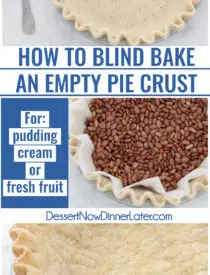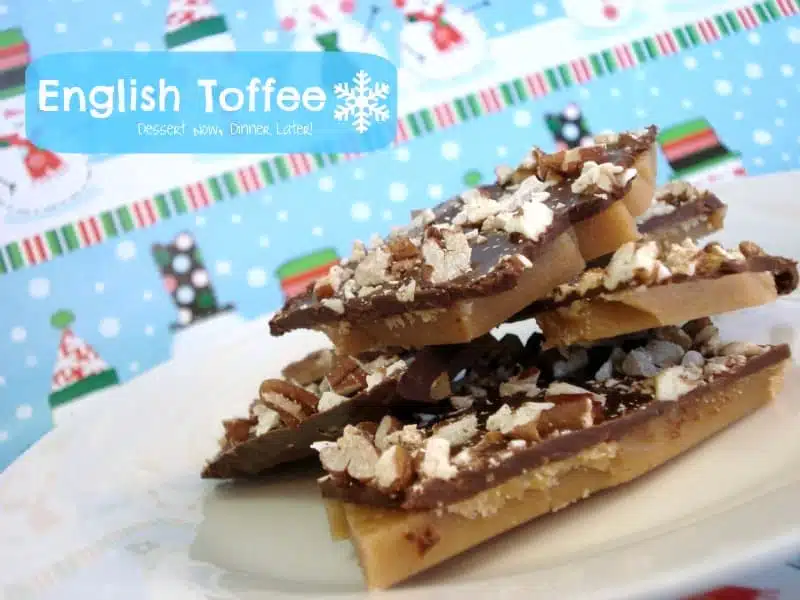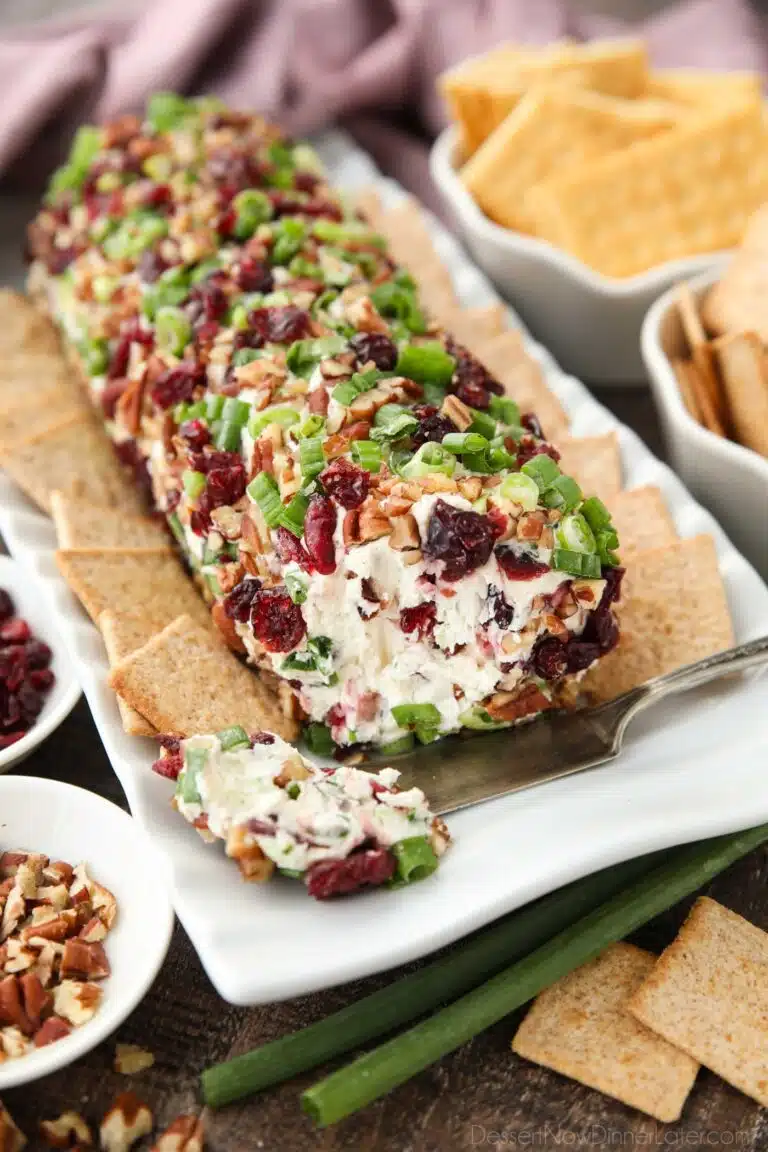How To Blind Bake Pie Crust
This photo tutorial will teach you how to blind bake pie crust without weights or shrinking. Use for cream pies, fresh fruit tarts, pudding pies, or any other soft-filling pie like lemon meringue.

What is Blind Baking a Pie Crust?
Blind baking a pie crust refers to baking an empty pie shell without any filling. Many sweet and savory pie recipes will use a partially or fully baked pie crust.
Do I need to blind bake my pie crust?
When do you need to blind bake a pie crust? There are two times when blind baking is needed: when making a custard pie or when the pie filling is unbaked.
Save This recipe
Enter your email below to get a link to this recipe emailed straight to you to save later! Plus be signed up for all new recipes.

Par-Baked
With a custard pie, like pumpkin or sugar cream pie, the moisture in the filling can make the crust soggy before it has time to bake through.
Partially baking the crust before adding the filling helps ensure the crust isn’t under-baked (raw) when the filling is done baking. Par-baking is also great for savory pies like quiche.
Completely Baked
For pudding, fresh fruit pies or tarts, and other cream pies, you will need a fully baked pie crust, as the filling is not baked with the crust.
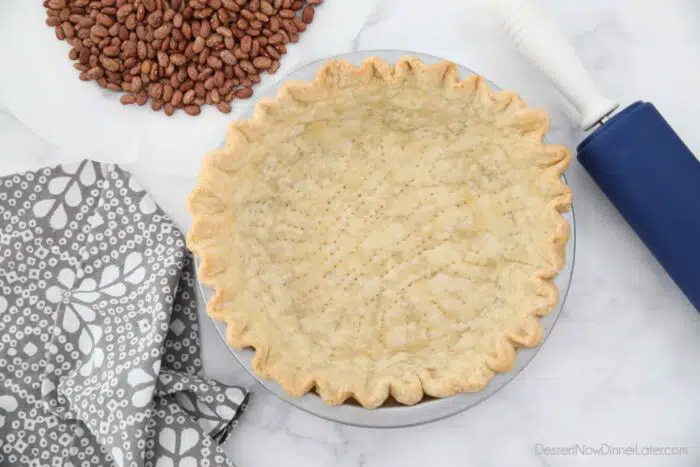
How to Blind Bake without Weights
You don’t need fancy pie weights in order to blind bake a pie crust. But the pastry crust must be weighed down with something so it doesn’t shrink.
Options for Pie Weights
It is likely that you have something already in your pantry that you can use to weigh down your pie crust. I was taught in culinary school to use dry beans or rice.
You want enough beans or rice to cover the bottom and come up the sides of the pie crust. Typically about 1 1/2 pounds. I prefer using beans because they’re easier to pick out of the crust if they fall overboard when being removed from the crust.
Keep in mind, you won’t be able to cook and eat the beans or rice after blind baking, but you can save them and use them again and again for the same purpose.

A newer method is to use granulated sugar and to leave it inside the crust during the entire baking process. Sugar is just as common of an ingredient as rice or beans, especially for avid bakers. Using sugar will create a more even weight distribution across the pie, providing complete coverage and less shrinkage. You can also re-use the sugar afterwards, which is great. (Blind baking with sugar just lightly caramelizes it, which gives it more flavor.)
In total honesty, I have not tried blind baking with sugar yet, but I’m planning to soon. I will, however, share with you the beans or rice method that I’ve used for 15+ years.
Parchment Paper vs. Foil for Lining Pie Crust
Besides having a weight for blind baking your pie crust, you need something to line the dough with. This is so the weight (beans, rice, etc.) doesn’t bake straight into the pie dough.
Classic blind baking uses a double baking method. The pie crust is first baked with weights to start baking the edges and prevent the crust from bubbling or sinking. Then the weights are removed and the crust is baked again to ensure that the bottom is crisp and completely baked through.
It is common to use parchment paper or foil to hold the weights and remove them from the crust for double blind baking.
Foil is quick to use, easy to shape, and can cover the edges of the crust well to prevent over-browning.
There is a slight risk of sticking or tearing and dropping your beans or rice into the pie crust when using foil. Been there done that. Picking little flecks of rice out of a partially baked crust is no fun at all. Definitely use heavy duty non-stick aluminum foil if you choose this route.
Parchment paper is easy to lift out of the crust without it sticking and I’ve never had it tear on me, so using parchment paper is my preference.
You can place a piece of parchment paper into the crust and add your weights to help form it to the sides and bottom of the pan. I like to make a parchment circle, so I’ll show you how, but it’s not totally necessary.
How to Make a Parchment Paper Circle

- Start with a square (or almost square) piece of parchment paper that is larger than the pie dish.
- First, fold the square in half upwards.
- Fold in half again, bringing the right side over to the left side.
- Fold the bottom left corner up to the top right corner, creating a triangle.
- Grab the top right corner and flip it over so it is on the top left.
- Then fold the top left corner over to the right edge.
- Hold the point in the center of the pie dish and draw a curved line 1-2 inches from the edge of the pan.
- Cut on the line and unfold the parchment circle.
How to Blind Bake Pie Crust
Now that you’ve got your pie weight and liner, you’re ready to go. This is how to blind bake a homemade pie crust using the double baking method.
First, make your favorite pie dough. Roll out the pie crust, place it in a pie dish, trim and crimp the the edges. TIP: Trim the dough a bit farther from the rim, and crimp the crust as far away from the inner sides as possible. (For less shrinkage.)
NOTE: A pie crust with shortening will hold its shape better than an all butter pie crust (used in these photos). But the butter crust has more flavor. Choose what’s most important to you.

Dock (prick) the crust all over the bottom and sides with a fork. This allows the steam to escape so that the pie crust doesn’t puff up in the oven. OPTIONAL: Chill pie crust in freezer for 10 minutes. This will help set the edges before the fat melts during baking.

Place parchment paper (or foil) into the crust and fill it to the top with dry beans or rice. This helps hold the crust in place and further prevents the crust from bubbling.

Bake at 350 degrees Fahrenheit for 20-25 minutes (until edges are just starting to brown). Then remove the parchment paper and weights (beans). Set the parchment paper and beans on a wire rack to cool completely. Save beans for future use. This first bake holds the crust in place while the crust partially bakes.
NOTE: If baking a custard pie, this is when you would add the filling.

Return crust to oven and bake at 350˚F for an additional 15-20 minutes or until golden brown and baked through. This second bake helps the crust crisp up and finish baking. It should look dry and crisp, not wet or oily. (If the crust is oily, the fat in the crust (butter or shortening) was too soft before it went in the oven.)

Blind Baking a Frozen Pie Crust
The method above is for a homemade pie crust. Which will take longer to bake than a store bought crust. Most store-bought crusts have much less dough and fat in them than most homemade pie dough, so they’ll brown much faster.
If buying pre-made, I would recommend using a frozen pie crust, rather than refrigerated dough, and bake it according to the directions on the package.
Example: Frozen Great Value pie crust instructs to thaw the crust for 15 minutes. Then prick the crust thoroughly with a fork, and bake it at 400˚F for 10-12 minutes.
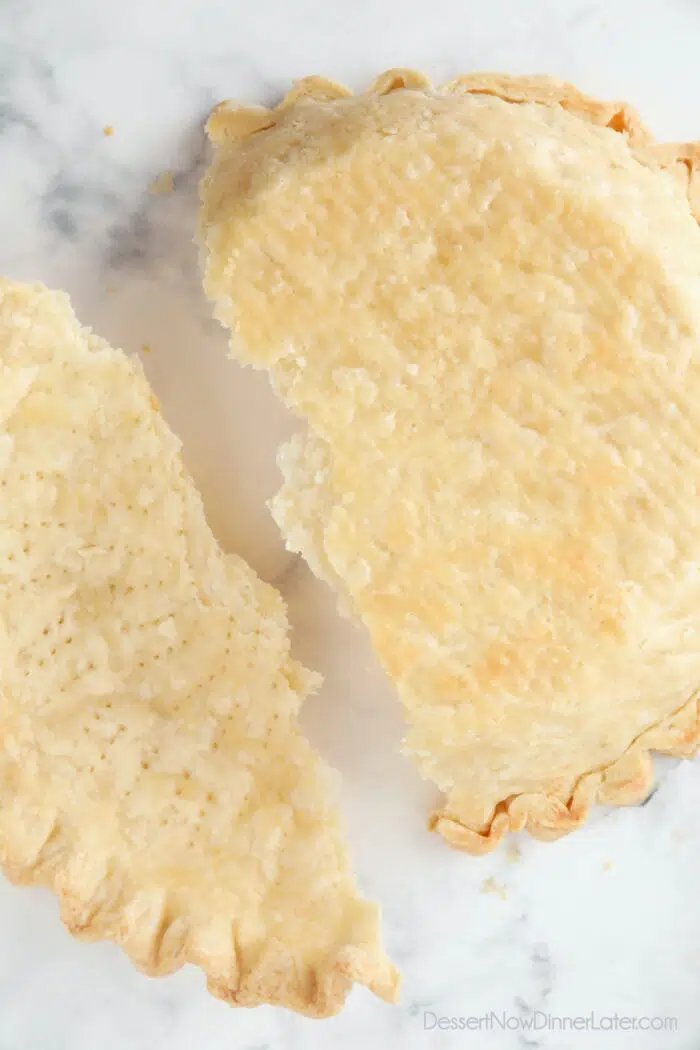
Additional Blind Baking Tips
Here are some additional tips to prevent the empty pie crust from shrinking during blind baking.
- Trim the dough a bit farther from the rim, and crimp the crust as far away from the inner sides as possible. Almost dangling off the edge, if you will. This is easiest to do in a pie plate with a wide rim. If the edges are farther from the middle, they are less likely to fall inside and shrink.
- Freeze the pie crust in the pan for 10 minutes before blind-baking. If the crust is slightly frozen when it goes into the hot oven, the outside edges will have a better chance of setting before the fat melts.
- Fill the weights to the top of the pie to hold pressure against the sides better.
Recipes That Use a Blind Baked Pie Crust
- Chocolate Cream Pie with instant pudding
- Blueberry Cream Cheese Pie
- Fresh Peach Pie Recipe
- Jello Coconut Cream Pie Recipe
- Strawberry Cream Pie
- Pink Lemonade Pie
- Chocolate Mint Pie

How To Blind Bake Pie Crust
Ingredients
Instructions
- Make pie dough and chill it. Preheat oven to 350 degrees Fahrenheit.
- Roll out the pie crust, place it in a pie dish, trim and crimp the edges. (See tutorial for either crust in links above.) NOTE: Trim the dough a bit farther from the rim, and crimp the crust as far away from the inner sides as possible. (For less shrinkage.)
- Dock (prick) the crust all over the bottom and sides with a fork.
- OPTIONAL: Chill pie crust in freezer for 10 minutes. This will help set the edges before the fat melts.
- Line parchment paper (or foil) inside the crust and fill it to the top with dry beans or rice.
- Bake at 350˚F for 20-25 minutes (until edges are just starting to brown). Carefully remove the parchment paper and weights and set on a wire rack to cool. (Can save beans to use again for this same purpose.)
- Return crust to oven and bake at 350˚F for an additional 15-20 minutes or until golden brown and baked through. NOTE: It should look dry and crisp, not wet or oily. (If the crust is oily, the fat in the crust was too soft before it went in the oven.)
- Cool completely, then fill with fresh fruit, pudding, cream, or other soft filling.
Notes
Nutrition
Did you make this?
Don’t forget to leave a rating below and make sure to follow on Pinterest and Instagram for more!
